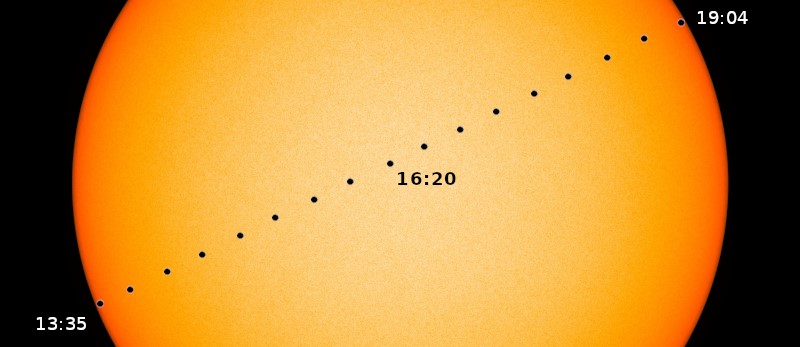Tránsitos planetarios
El último tránsito de Mercurio sobre el disco solar ocurrió el 11 de noviembre de 2019. El próximo tendrá lugar el 13 de noviembre de 2032.
El último tránsito de Venus sobre el disco solar ocurrió el 5 de junio de 2012. El próximo tendrá lugar el 11 de diciembre de 2117.
¿Qué es un Tránsito?
Se denomina tránsito al paso de un planeta por delante de la superficie del Sol. Desde la Tierra sólo se pueden ver los tránsitos de los planetas más interiores: Mercurio (unos 13 por siglo) y Venus (unos trece por milenio).
Se producen cuando el Sol, el planeta interior y la Tierra se encuentran perfectamente alineados. La rareza de estos fenómenos se debe a la ligera inclinación existente entre las órbitas de los planetas.

Precauciones al observar
NO se debe observar el Sol directamente, NI con métodos caseros (negativos, cristales ahumados,…). NO se puede mirar por un telescopio o binocular que esté apuntando directamente al Sol. SIEMPRE hay que utilizar la protección adecuada: gafas de eclipse y filtros solares para los aparatos ópticos.
Podemos optar por observar la imagen del Sol proyectada en una pantalla. Dada la pequeñez del disco de Mercurio, el tránsito no es perceptible a simple vista (con gafas de eclipse), para obtener una imagen mayor y más nítida se puede usar un pequeño telescopio o unos prismáticos (que soporten la intensidad de la luz del Sol) para proyectar la imagen en una pantalla blanca. Conviene dejar enfriar el aparato cada pocos minutos de observación, para evitar dañarlo, especialmente su ocular; hay que recordar que un tránsito es un fenómeno que transcurre lentamente a lo largo de varias horas.
¿Sabías que?
Los tránsitos planetarios han tenido una importancia capital en la historia de la astronomía. Durante los siglos XVIII y XIX se organizaron expediciones internacionales por todo el planeta para medir la duración de los tránsitos desde distintos puntos de la superficie terrestre y, a partir de estas medidas, determinar la distancia al Sol.
En la actualidad los tránsitos son el principal método para la detección de planetas extrasolares.
¿Quieres saber más?
Tránsitos. La medida del Sistema Solar y de otros sistemas planetarios
Autor/Autores: Pere Planesas Bigas
Fecha de edición: 2019
Número de páginas: 48
Resumen del libro:
¿Cómo se determinó la distancia al Sol? ¿Cómo se descubrió la anomalía de la órbita de Mercurio, que sería el primer fenómeno explicado mediante la teoría general de la relatividad de Einstein?¿Cómo se descubren y caracterizan la mayoría de las órbitas de los planetas que giran alrededor de otras estrellas? La respuesta a estas tres preguntas es la misma: mediante los tránsitos.
La medida de la gran distancia de la Tierra al Sol se logra en la era moderna mediante una combinación del ingenio de Halley, nuevos instrumentos y la participación entusiasta de centenares de astrónomos profesionales y aficionados en el tránsito de Venus.
Descárgate este libro gratuito de historias sobre tránsitos «Tránsitos. La medida del Sistema solar y de otros sistemas planetarios».


